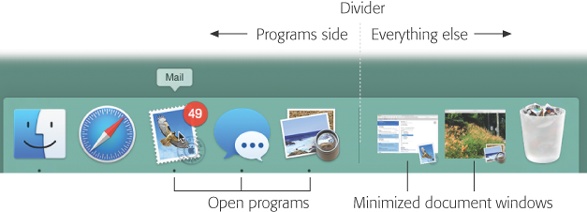Setting Up the Dock
Apple starts the Dock off with a few icons it doesn’t want you to miss: Finder, Launchpad, Mission Control, App Store, Mail, the Safari Web browser, and so on. But using your Mac without putting your own favorite icons in the Dock is like buying an expensive suit and turning down the free alteration service. At the first opportunity, you should make the Dock your own.
The concept of the Dock is simple: Any icon you drag onto it (Figure 2-21) is installed there as a button. You can even drag an open window onto the Dock—a Microsoft Word document you’re editing, say—using its proxy icon (The Folder Proxy Icon) as a handle.
Tip
If you right-click a folder, or any other icon, in the Sidebar (The Finder Sidebar), you get an Add to Dock command for that icon. Bet you can’t guess what it does.

Figure 2-21. To add an icon to the Dock, simply drag it there. You haven’t moved the original file; when you release the mouse, it remains where it was. You’ve just installed a pointer—like a Macintosh alias or a Windows shortcut.
A single click, not a double-click, opens the corresponding icon. In other words, the Dock is an ideal parking lot for the icons of disks, folders, documents, programs, and Internet bookmarks that you access frequently.
You can even install batches of icons onto the Dock all at once—just drag them as a group. That’s something you can’t do with the other parking ...
Get Switching to the Mac: The Missing Manual, Yosemite Edition now with the O’Reilly learning platform.
O’Reilly members experience books, live events, courses curated by job role, and more from O’Reilly and nearly 200 top publishers.

